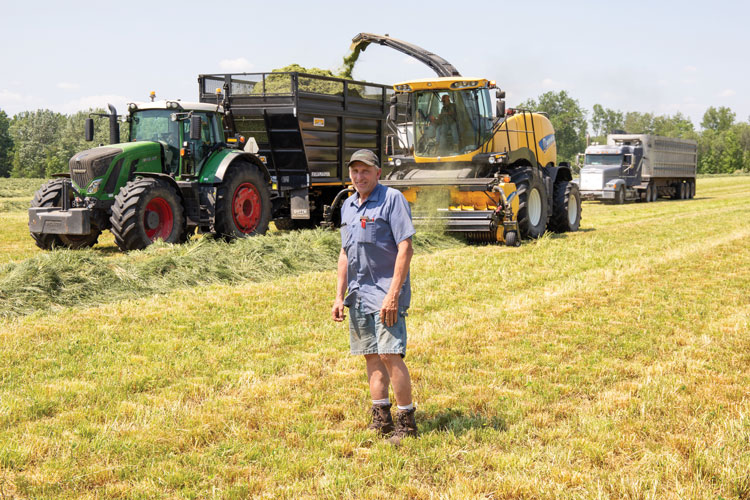
Operating any dairy farm isn’t easy, but milking over 1,600 cows brings farm and employee oversight to an even greater level. Next, let’s make it an organic farm in the Upper Midwest and only feed high-quality forage crops — no grain. Raise your hand if you’d like to volunteer.
It’s likely that not too many hands are up, but Ed Zimba wouldn’t make his living milking cows any other way. He and his wife, Melanie, own and operate Zimba Dairy in Michigan’s Thumb Region. The 60-year-old Zimba is passionate about the health of his soils, his cows, and the greater human population.
Zimba’s father was an autoworker in Detroit who eventually saved enough to purchase a farm and was wise enough to grow it along with his family of seven children. The farm would eventually be split between the three sons, and Zimba bought out his brothers’ portions of the 150-cow dairy herd in 1990. He converted the farm and cows to organic production immediately, moving the herd from confinement-based housing to a rotational grazing-based system. More recently, he converted to all grass-fed, selling his milk to Horizon Organic.
Grown from within
The Zimba herd has primarily grown internally from those early days. According to the farm’s long-time veterinarian, Mark Fox, this has helped curtail some of the disease problems that many expanding herds have when they purchase and add large numbers of replacements. “The organically raised and cared for cow doesn’t realize that she’s organic,” Fox noted. “We don’t use many organic treatments anymore, but rather try to focus almost entirely on prevention and excellent husbandry. It takes a great team of dedicated employees to pull this off, which Ed has,” he added.
“We live and learn like everyone else,” Zimba said. “But I’d never go back to farming with chemicals, although I’ve got nothing against my neighbors, including my brothers, who do. I just believe this is how we should farm.”
If you get the idea that Zimba is willing to share his opinions — you’re right; however, you can’t argue about the success of what he’s been able to accomplish during the past 30-plus years. Zimba now farms about 4,000 acres. In addition to the milking herd, he also cares for about 1,900 head of youngstock and has a cow-calf beef enterprise totaling 200 head of brood cows. The dairy herd is milked on two separate farms, each with its own parlor.
Forage quality is Job 1
Zimba grows 1,800 acres of an alfalfa-grass mixture and 1,500 acres of male-sterile corn along with 700 acres of dedicated pasture, much of which is irrigated. Triticale or winter rye is grown following corn silage harvest and his new alfalfa-grass seedings are no-tilled into the winter annuals during early spring when the soil is dry enough. “We’ve had really good success doing it this way,” Zimba said. “We take the triticale off in the boot stage to give the new seeding a chance to develop. This year’s triticale had a TDN of about 65%.”
The alfalfa-grass mixtures are cut five to six times per year to maximize forage quality. “When all that you feed is forage, the energy levels have to be high to get milk out of cows,” Zimba explained. The farm relies heavily on grass species such as Italian ryegrass, festulolium, and soft-leaf tall fescue to mix with the alfalfa. This year, the farm’s first-cut haylage came off the field with a relative forage quality (RFQ) of 225 to 235. Harvested forage is chopped and stored in bunker silos.

Around the two dairies, a person can see nothing but well-maintained cow lanes and pastures broken into paddocks, which are further divided by polywire as needed. Pastures are assessed annually for productivity and, if deficient, are interseeded in the spring with red clover, ryegrasses, and tall fescue.
Growing organic crops means that many conventional fertilizer options aren’t able to be used, but that doesn’t mean soil fertility is any less important. “We test all of our fields for both nutrient status and soil health,” Zimba noted. “We can use potassium sulfate, gypsum, and boron for alfalfa. Manure is also spread routinely. For fields farther away where hauling liquid manure is prohibitive, we’ll purchase chicken litter.”
A recent addition to the Zimba’s farm has been the construction of a covered compost barn. A used commercial compost turner was purchased to expediate the composting process. “We’re still learning what techniques will work best, but the drier material is easier to handle and can be hauled longer distances.”
Healthy, happy cows
Optimizing milk production is important to the second-generation farmer. He’s tried several breeds of dairy cows and crossbreds over the years but has settled on Holsteins. “The higher price we get on our grass-fed milk makes it more feasible to push for volume,” Zimba said. “We also milk three times per day and bring the cows to the barn when the weather is too hot. We’ve always got cows on the move somewhere. Each time they go back out, they’re given new grass. We graze from early May until deer hunting season, and during the winter, the cows are fed a totally mixed forage ration in the barn,” he added.

Even with attention to details, feeding an all-forage diet isn’t for the weak of heart. Weather challenges in getting a high-quality crop in storage are amplified. Cow care is also put to the test. “I was quite skeptical when Ed transitioned over to a grass-fed diet,” said veterinarian Fox. “My greatest worry was that fresh cows would be under more risk for ketosis and subsequent reproduction challenges, but this turned out not to be the case. Obviously, start up and peak milk production is substantially lower than with a conventional TMR confinement herd, but metabolic diseases in fresh cows are virtually nonexistent and reproduction efficiency never dropped off.”
Commenting further on Zimba’s dairy herd, Fox noted that milk quality, which is sometimes an issue on organic herds, has not been a problem. “Somatic cell count (SCC) numbers throughout the year are impressive for a dairy that uses no antibiotics,” he said. “The freestalls are bedded with virgin sand, and cows have access to pasture when the weather allows. This gets them off the concrete, which helps from a space and the rest standpoint.”
Zimba Dairy is nonconventional in many ways, but it is conventional in many others. There is a heavy focus on forage quality, cows are intensively grazed, cows are sometimes confined, TMRs are mixed, crop yields are optimized, soil health and fertility are prioritized, mistakes are sometimes made, and employees are treated with respect and are well trained. All of these characteristics amount to a big “thumbs up” in Michigan’s Thumb. •
This article appeared in the November 2023 issue of Hay & Forage Grower on pages 18-19.
Not a subscriber? Click to get the print magazine.

